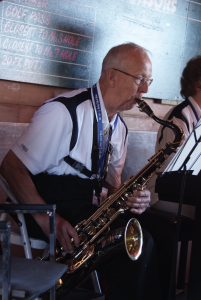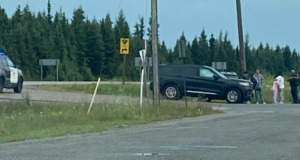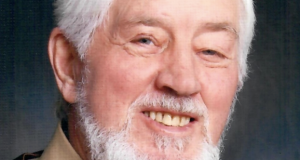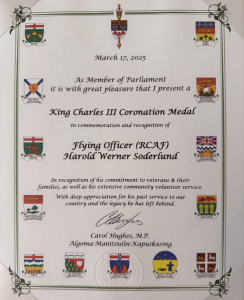 The Soderlund family and the Executive, Membership and Ladies Auxiliary from the Royal Canadian Legion Branch 429 in Wawa invite you to join us for a commemorative gathering to acknowledge the late Comrade Harold Soderlund receiving the King Charles III Medal.
The Soderlund family and the Executive, Membership and Ladies Auxiliary from the Royal Canadian Legion Branch 429 in Wawa invite you to join us for a commemorative gathering to acknowledge the late Comrade Harold Soderlund receiving the King Charles III Medal.
Editor’s Note – For those who didn’t know Harold, this article resides in the Veteran’s Stories on The Veterans Commemorative Monument website. Fundraising continues towards the building of this monument to be located at Rowswell Park (Compass Point) in Sault Ste. Marie, Ontario.
Harold was also a proud member of the Rotary Club of Wawa (1966-08-01) until he relocated to the Soo, and became a member there.
Harold Soderlund
“We had survived the rather heavy odds of crashing into the sea at night… In a war, battles are often fought in faraway places and men and women will lose their lives. Often luck plays a part in their survival. That was so for me on the night of August 30th, 1944,” recounts Canadian Air Force (CAF) Pilot Harold Soderland. This was Soderland’s last flight in World War II, which led to his nine-month internment as a Prisoner of War (POW).
Harold Soderlund was born in 1921 on a farm near Sturgis, Saskatchewan. He and his Swedish immigrant family owned a farm, which became a source of comfort and provisions for the poor during the Depression Era. Growing up on his family farm provided Soderlund with ample opportunity to practice his craft of construction, which inevitably resulted in him building a log cabin which bordered on his parents’ property.
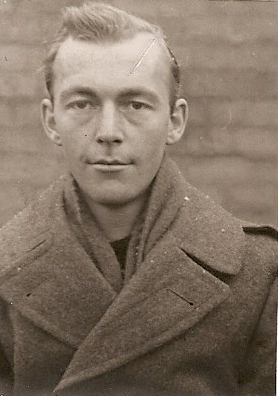 His relatively routine life changed when the Second World War erupted in 1939. In 1941, after the Government of Canada established the Dominion Provincial Youth Training Plan (DPYTP) for young men interested in joining the CAF, Soderlund enlisted. “I decided that this was an opportunity to escape the tedium of sitting behind four horses (the view was uninspiring) and riding a cultivator or plough.” With a close friend, Soderlund climbed aboard a railcard destined for Saskatoon to begin his six months of training, which including welding work and the extensive studying of aircraft engines. For Soderlund, this was also his first taste of big city living.
His relatively routine life changed when the Second World War erupted in 1939. In 1941, after the Government of Canada established the Dominion Provincial Youth Training Plan (DPYTP) for young men interested in joining the CAF, Soderlund enlisted. “I decided that this was an opportunity to escape the tedium of sitting behind four horses (the view was uninspiring) and riding a cultivator or plough.” With a close friend, Soderlund climbed aboard a railcard destined for Saskatoon to begin his six months of training, which including welding work and the extensive studying of aircraft engines. For Soderlund, this was also his first taste of big city living.
After successful completion of the DPYTP at the Saskatoon Technical Collegiate, Soderlund joined the Royal Canadian Air Force and went to the Manning Depot in Brandon, Manitoba. Here, Soderlund had his first encounter with military discipline, guard duty, and route marches. These weren’t the glorified activities Soderlund expected upon enlisting. Fortunately for him, his routine duties were short lived as he was posted to St. Thomas, Ontario to a former insane asylum building, equipped with barred windows, which lodged Air Force recruits for further training.
After St. Thomas, Soderlund was posted back to his home province, to Yorkton, Saskatchewan. Soderlund logged plenty of airtime in Yorkton as a passenger on test flights with pilots. The exuberance of being airborne, coupled with experiencing his first loop in midair, convinced him to switch from being ground crew to aircrew within the CAF. This change in heart brought him to Rivers, Manitoba in the fall of 1942 for flight training, where he spent nine hours completing in-course instruction, prior to taking his first solo flight. After a brief visit home, Soderlund ventured via train to Clarenshome, Alberta where he was awarded his pilot wings and was commissioned as a Pilot Officer after 60 hours spent in the air.
In February of 1943, in Summerside, Prince Edward Island, Soderlund completed a six-week course in aircraft navigation, prior to finally being posted overseas. Here, he also received crucial operational training on the Beaufighter, a twin-engined plane, known for its strengths in both the daylight and evening hours. The plane was equipped with four 20 mm canons and eight armour piercings or explosive head rockets. Some even carried torpedoes. “This aeroplane was called the ‘Whispering Death’ by the enemy because of the low engine noise.” Those onboard the plane included the pilot and a navigator or gunner. A machine gun was also mounted in the navigator’s compartment for defence against rear attacks.
Nearly five years after enlisting, Soderlund was finally posted overseas. In January of 1944, he received his post to the 603 City of Edinburgh Squadron, where he was tasked with attacking enemy shipping facilities in the Aegean Sea. He received plenty of “experience in flying that [wa]s not taught in class”, including how to fly a plane that had endured heavy gunfire and how to fly a plane through extreme weather, including thunderstorms.
On 30 August 1944, Soderlund’s plane was shot down and he became a Prisoner of War of the axis powers. “My navigator, Sergeant Ian Nichol and I were assigned to patrol the Aegean Sea north of Crete. The enemy was evacuating the Island of Crete at this time. At the half-way point of our patrol and at an altitude of 200 feet, I set a course for the homeward journey and coincidentally this provided a brilliant full moon path ahead of our aircraft.” Ahead in the moonlight, was an enemy aircraft, a Junker Ju 52. With his training in the back of his mind, and the feeling of duty and obligation taking over him, he immediately began to pursue the enemy in his Beaufighter, who was perhaps 2,000 feet away. When the enemy was in distance, he fired with his 20-mm cannon. He doubts the enemy was actually hit.
“In turning to port to break off the attack, our Beaufighter almost collided with another Junkers 52 flying in the opposite direction to the first one. At this point, I made the mistake of continuing in pursuit of the second Junkers. Bullets from his rear gun hit our port engine and it quickly lost power. I attempted to feather the propeller to reduce drag, at the same time straining to keep the aircraft flying straight against the pull of the still functioning starboard engine. The propeller did not feather and I could see flames at the back of the port engine. All my thoughts and energy were now concentrated on keeping the Beaufighter flying but a slight bump at the back of the aircraft meant the tail end had touched the water. Moments later the Beaufighter slid onto the water. I hit my head on the windscreen as the aircraft came to a sudden stop with the nose in the water. I quickly opened the overhead escape hatch and hit my parachute and seatbelt release button and climbed out on the wing. Ian Nichol was already there.”
Within seconds, the Beaufighter had sunk beneath them, into the depths of the ocean. Luckily, both Soderlund and Nichol were wearing lifejackets and the Aegean Sea was warm this time of year. One of the two dinghies within the now sunk aircraft floated to the surface. “This was another of the fortunate circumstances that contributed to our survival. We inflated it and climbed in. My feet dangled in the water. A fully-lit hospital ship was passing some distance away and we tried attracting attention with one of the small lights aboard the dinghy but to no avail. The enemy aircraft circled a couple [of] times with a landing light on but did not see us.”
A few days later, Nichol and Soderlund had drifted toward the occupied town of Candia on Crete, and a German patrol boat ventured to their dinghy, capturing them. That evening, both were placed aboard a Junkers Ju 52 with German soldiers being evacuated from Crete. The plane took its passengers to Athens, Greece, and fortunately, without any encounters from the 603 Squadron. Nichol and Sunderland were held prisoner in a former school building, where their guard and a former schoolteacher informed them that “in Germany, if you were told that black was white you had better believe it.”
After a week in the school, all the POWs were placed on a train, bound for Salonika, Greece. The train travelled at night without any lights. Knowing that his future was bleak, Soderlund attempted to escape through a tiny window near the top of the carriage. He had nearly escaped when Russian prisoners alerted the guard. “I quickly dropped back down and I heard the click of a rifle bolt. No light came on and the incident passed. I often wonder if I had made it out how this story may have changed.”
At the prison compound in Salonika, Soderlund and Nichol were joined by several P-38 Lightning pilots who were shot down while attacking aerodromes in the vicinity. German guards told them that they were Chicago gangsters.
After arriving in Salonika, the POWs travelled in the forward compartment of a transport truck to Skopkle, Bulgaria. Upon arrival to Bulgaria, several Junkers 87 Stuka dive bombers dove on the aerodrome, dropping their bombs. “The guards had taken us outside the aerodrome as the sirens sounded. It was an encouraging sign. We learned that the planes were captured from the Germans and flown by Romanian pilots who had by this time been liberated. The aerodrome at Skopjle, Bulgaria was quickly repaired after the Stuka dive bomber raid and after sunset I was placed aboard a Junkers 52 again with German soldiers and the plane took off. The journey was not without excitement. At one point the plane was rocked by bursting anti–aircraft fire.”
Soderlund’s flight landed in Zagreb, Yogoslavia, where he was then put in a holding room. That same day, he once again was put onboard a passenger train, destined for Budapest, Hungary. “There was a tourist aspect to this journey because I could observe the scenery in the lovely countryside. Crossing the Danube River it was noticeable that some repairs were done to the bridge. I soon found myself in a narrow cell at the Budapest penitentiary. After a few days, I was placed aboard a 40-man or four-horse carriage along with other prisoners and the train headed westward. In a couple of days, the train arrived at Frankfurt which was the interrogation centre for aircrew prisoner. I saw at this time the rubble of bombed out buildings firsthand. The interrogation officer suggested that since I had no identification that I could be turned over to the Gestapo… After a week I found myself aboard another train headed for Stalag Luft 3.”
Almost a month after he had been shot down, Soderlund arrived at Stalag Luft 3. He estimates it was around 1 October 1944. “The camp had a library of sorts and one could exercise within the camp grounds. Food consisted of a dark, heavy bread and a thin soup once a day. The International Red Cross was allowed to bring in concentrated food parcels approximately 10 inches square by three inches deep once a month and this was a Godsend. As I recall we could send out one letter a month. Showers were cold water; our beds were straw mattresses on wood slats. A clandestine radio procured by some ingenious prisoners provided news which was passed around in a book. We knew of the crossing of the Rhine at Reymegan.”
By February, the Russians were approached Stalag Luft E. All prisoners were marched to various destinations. Soderlund’s group took five days on foot to reach Luckenwald, a city south of Berlin. They could hear the bombing of Berlin.
By April, the Russians were nearing Luckenwald. “A Russian tank came and knocked down the gate and we were able to get out in the countryside. An American convoy of trucks came to take us away but the Russians refused to let us go. It was not till a week or so later that agreement by the Russian and Allied generals allowed our return to Western Germany and evacuation to Britain. The war was over and the next move was back to Canada… This end[s] the account of my war experience … I tell it not to glorify war but to relate how I and my navigator/gunner survived by luck and the grace of God.
I am proud that I did my part as I was expected to do although I lost the battle. In life you must do your best to succeed but sometimes you lose and sometimes you win. Always do your best and you will find confidence in yourself and pride in what you can accomplish.”
http://thosewhoserved.ca/veterans-stories/
- Collision at Mills Drive - August 9, 2025
- Beautiful Sunrise - August 9, 2025
- Saturday Morning News – August 9th - August 9, 2025
 Wawa-news.com You can't hear the 'big picture'!
Wawa-news.com You can't hear the 'big picture'!
